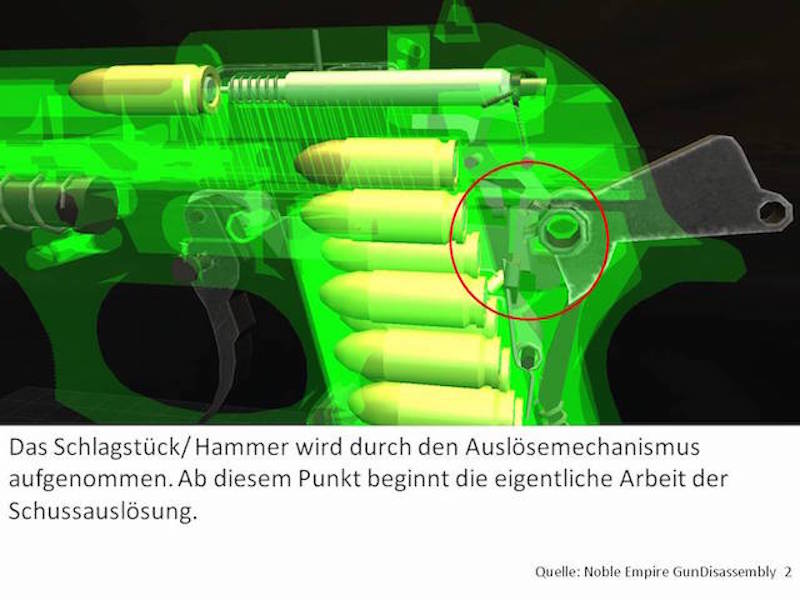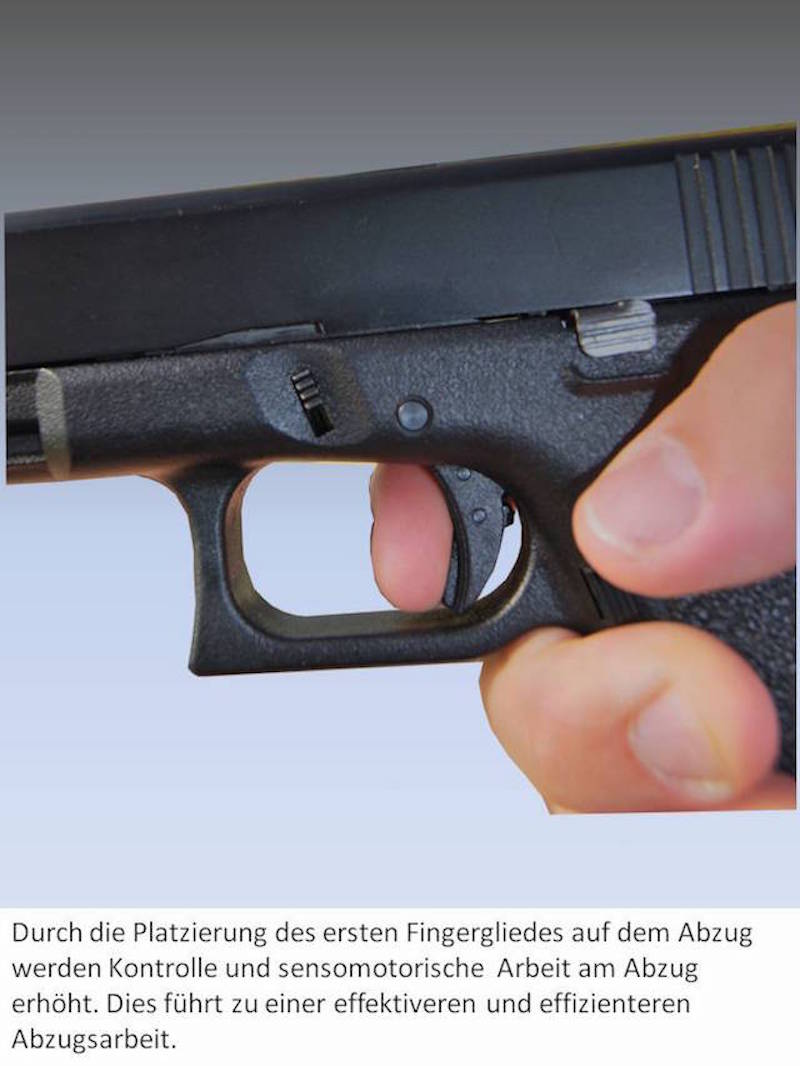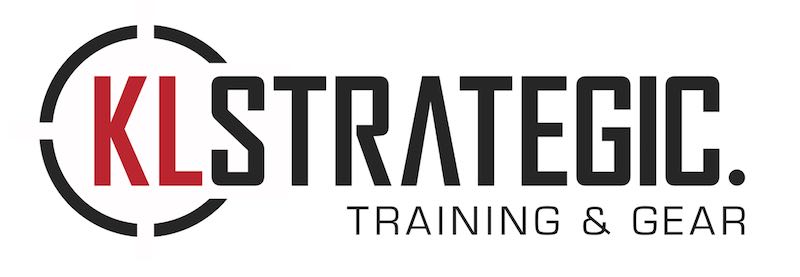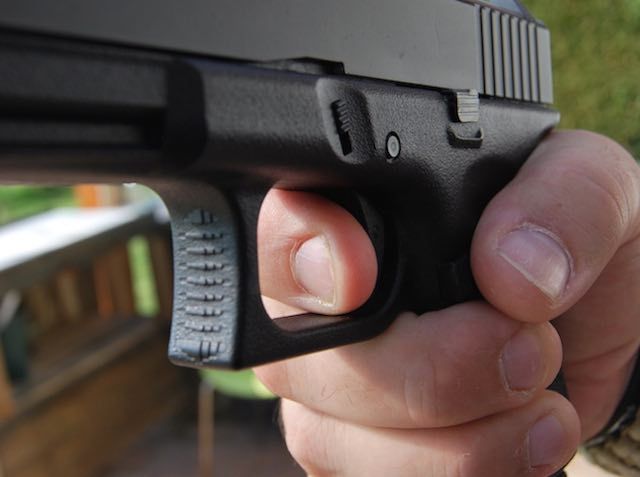Hol Dir den wöchentlichen SPARTANAT-Newsletter.
Dein Bonus: das gratis E-Book von SPARTANAT.

TRAINING MIT KL STRATEGIC (5): Die Abzugsarbeit
Die Abzugsarbeit ist ein komplexer Ablauf, der wesentlichen Einfluss auf einen Treffer hat. Hierbei können bereits kleine Fehler große Auswirkungen haben.
Die Abzugsarbeit ist ein komplexer Ablauf, der wesentlichen Einfluss auf einen Treffer hat. Hierbei können bereits kleine Fehler große Auswirkungen haben.
Gerade für Anfänger stellt die kontrollierte Abzugsarbeit bzw. Abzugskontrolle eine große Herausforderung dar. Getunte Abzüge mit geringem Abzugsweg und niedrigem Abzugsgewicht erschweren das Erlernen dieser Kontrolle unweigerlich, auf Grund ihrer sehr sensiblen Einstellungen.
Doch was ist es, das den Unterscheid zwischen Abzugskontrolle und dem reinen Abkrümmen ausmacht?
Zum Einen ist es das Wissen darüber, dass die Bewegung des Abzuges weit mehr Auswirkungen hat, als nur den Schuss brechen zu lassen; zum Anderen ist es eine bewusste und kontrollierte Bewegung, bei der Einfluss auf die Waffe genommen wird.
Gerade der zweite Teil ist immens wichtig, bedeutet er doch einen deutlichen Widerspruch zur Schießausbildung der Vergangenheit.
Während bis vor einigen Jahren noch gesagt wurde, man soll sich beim Abkrümmen vom Schuss „überraschen“ lassen, weiß man es heute besser. Im Umgang mit Schusswaffen ist es wichtig, genau zu wissen, was man tut – dem entsprechend sollte ein Schütze auch wissen, wann ein Schuss bricht. Dies erfordert Übung und Erfahrung mit der eigenen Waffe, also kurz gesagt, nichts anderes als Training, Training, Training.
Die kontrollierte Abzugsarbeit hängt also eng mit dem mindset und natürlich den praktischen Kenntnissen und Fertigkeiten zusammen.
Gehen wir aber mal auf den ersten o.g. Aspekt ein: Wissen über die Auswirkungen der Bewegung am Abzug!
Wer sich eine Waffe betrachtet wird feststellen, dass die Bewegungsrichtung doch sehr stark vorgegeben ist, nämlich Vor und Zurück.
Innerhalb dieses Spielraumes ist der Abzugsweg, je nach Art des Abzuges, mehr oder weniger groß. Alles haben jedoch alle Abzüge gemeinsam. An einem – je nach Abzug definierten – Punkt wird das Schlagstück durch die Abzugsmechanik aufgenommen und ab hier beginnt der eigentliche Auslösevorgang des Schusses.
 Bei Druckpunktabzügen ist dieser sehr deutlich – nach einem gewissen Vorzugsweg – spürbar; bei Stechern und Direktabzügen ist dieser Punkt i.d.R. sofort bzw. nach einem äußerst geringen Vorweg erreicht.
Bei Druckpunktabzügen ist dieser sehr deutlich – nach einem gewissen Vorzugsweg – spürbar; bei Stechern und Direktabzügen ist dieser Punkt i.d.R. sofort bzw. nach einem äußerst geringen Vorweg erreicht.
Der Einfachheit halber möchte ich die Abzugskontrolle anhand eines Druckpunktabzuges weiter erläutern.
Die kontrollierte Abzugsarbeit beginnt bereits beim Platzieren des Abzugsfingers. Hier beginnen sich bereits die Geister zu scheiden; jedoch hat sich unabhängig voneinander in diversen Bereichen eine Methode durchgesetzt.
Bei dieser wird das erste Fingerglied mit dem empfindlichen Zentrum auf dem Abzug platziert. Dies hat gleich mehrere Vorteile:
- Die Möglichkeit des geraden Abkrümmens ist so bereits natürlich gegeben ( siehe weiter Unten)
- Durch die sensiblen Tastnerven in diesem Bereich des Fingers ist das Erreichen bzw. wieder Erreichen des Druckpunktes deutlich zu erfühlen.
- Die Gefahr den Abzug seitlich zu Drücken/ Ziehen ist beinahe ausgeschlossen
Ziel des Abkrümmens ist es, den Abzug stetig kontrolliert, parallel zur Rohrseelenachse zu bewegen, bis der Schuss bricht. Nur dann ist ein seitliches Abkommen durch Abzugsfehler ausgeschlossen.
Im nächsten Schritt wird der Abzug kontrolliert den Vorzugsweg entlang bis zum Druckpunkt gebracht. Bereits hierbei ist darauf zu achten, den Abzug nicht seitlich zu drücken. Sofern die Platzierung des Abzugsfingers nicht korrekt erfolgt ist, kann dies zum Verdrehen der Waffe im Griff führen.
Beispiel:
Ein Rechtsschütze legt den Finger mit dem ersten Fingergelenk auf den Abzug. Dies führt in aller Regel dazu, dass sich der Abzugsfinger während des Abkrümmmens um den Abzug „rollt“ und somit seitlicher Zug nach Rechts auf den Abzug ausgeübt wird. Dies führt zum Einen dazu, dass das Abzugsgewicht subjektiv als höher empfunden wird, als es tatsächlich ist, da der Abzug in eine nicht vordefinierte Richtung bewegt wird, zum Anderen wird die Waffe im Griff nach Rechts gedreht, was zu seitlichen Ablagen des Treffers führt. Ein weiteres Anzeichen für diesen Fehler ist das neue Etablieren des Griffes nach jedem Schuss.
Sinngemäß umgekehrt verhält es sich, denn der Finger nur mit der Fingerspitze auf den Abzug gelegt wird. Hierbei kommt es zu einem Verdrehen der Waffe nach Links durch seitliches Drücken des Abzuges.
In diesem Beispiel kann man erkennen, wie wichtig das Zusammenspiel zwischen den einzelnen Faktoren des Schießablaufes ist.
Wie bereits im ersten Artikel (Griff) angesprochen stellen diese Zusammenhänge einen wichtigen Anteil am Gesamttreffer dar und fordern ein hohes Maß an Konzentration. Der Griff beeinflusst bereits stark die Möglichkeiten zum Platzieren des Abzugsfingers. Nicht zuletzt deswegen ist dem Griff so ein hoher Anteil am Treffer anzurechnen.
Nach Erreichen des Druckpunktes wird dieser durch gleichmäßigen Druck parallel zur Rohrseelenachse überwunden, bis der Schuss bricht. Dies erfolgt i.d.R. nach dem Überwinden eines kurzen Weges, bei dem der Hahn/ das Schlagstück durch die Abzugsmechanik frei gegeben wird. Dies variiert bei jeder Waffe etwas und hängt mit den Fertigungstoleranzen zusammen.
Wie bereits zuvor angesprochen sollte ein Schütze wissen, wann bei seiner Waffe der Schuss bricht und sich nicht „vom Schuss überraschen lassen“ (Warum dies so wichtig ist, wird weiter unten erläutert).
Ab diesem Punkt trennt sich die Spreu vom Weizen, denn ungeübte Schützen lassen hier den Abzug los. Will man jedoch gezielte Schüsse anbringen, oder auch schnelle Schussfolgen ausführen, ist es wichtig, den Finger auf dem Abzug zu belassen und diesen weiter bis zum hinteren Anschlag zu führen. Die hierzu benötigte Zeit ermöglicht es, den Rückstoß aus der Waffe über den Körper ( siehe Teil II – Anschlag) abzuleiten und die Waffenbewegung zuende zu führen.. Dies wird landläufig als sog. Nachhalten bezeichnet. Durch das weiterführen des Abzuges bis in den hinteren Anschlag bleibt die Waffe ruhig im Anschlag und fällt bei Nutzung des natürlichen Haltepunktes (siehe Teil 3- natürlicher Haltepunkt) wieder auf diesen zurück, so dass im weiteren Verlauf schnell eine erneute Schussauslösung erfolgen kann.
Warum wirkt sich das Loslassen des Abzuges negativ aus?
Wird der Finger nach der Schussauslösung schlagartig vom Abzug gelöst, treten folgende negative Faktoren auf:
- Unnötige, ruckartige Bewegung in der Waffe. Diese führt zum „Verreißen“
- Eine erneute Schussauslösung ist erst nach neuem Platzieren des Abzugsfingers möglich. Dies kostet Zeit und Konzentration, sowie ggf. die Durchführung eines neuen Zielvorganges. Im Allgemeinen als unnötige Bewegungen bezeichnet
- Eine schnelle Schussfolge ist durch das aufkommende „Trigger hammering“ kaum mehr effizient möglich, das durch das schnelle Lösen und Durchreißen des Abzuges sehr viel unnötige Bewegung in die Waffe kommt, was bei schnellen Schussfolgen unweigerlich zu Tiefschüssen ggf. mit seitlichen Ablagen führt.
Im Weiteren Verlauf des kontrollierten Abkrümmens wird der Abzug aus der hintersten Position konzentriert wieder bis zum Druckpunkt gebracht. Hier stellt die o.a. Position des Abzugsfingers eine positive Rolle, da das Wiederaufnehmen des Schlagstückes gefühlt werden kann. Von hier aus kann eine erneute schnelle und kontrollierte Schussauslösung erfolgen, oder aber der Finger vom Abzug gelöst werden, um die Serie zu beenden, die Position zu wechseln, oder aber andere Tätigkeiten auszuführen.
Wenn man sich diesen Ablauf einmal unter dem Sicherheitsaspekt betrachtet, stellt man fest, dass die 4 grundlegenden Sicherheitsregeln sogar für diesen Ablauf sprechen:
Regel 3:
Der Abzugsfinger berührt den Abzug erst, wenn die Mündung auf das Ziel gerichtet ist und verlässt diesen, sobald die Mündung das Ziel verlässt.
Dies bedeutet im Umkehrschluss, dass der Abzugsfinger durchaus so lange auf dem Abzug verbleibt, wie die Mündung auf das Ziel gerichtet ist!
Auch unter dem Aspekt der Effizienz zeigt die beschriebene Methode deutliche Vorteile gegenüber Anderen. Unter Effizienz versteht man im Allgemeinen das Erreichen eines geforderten Zieles unter geringst nötigem Mittel- und Zeitansatz. Die vorgestellte Methode erfüllt genau dies, indem die Bewegungen auf ein absolut nötiges Minimum reduziert und zieloptimiert durchgeführt werden.
Nun wird auch ersichtlich, warum ein „vom Schuss überraschen lassen“ nicht zielführend ist. Nicht nur, dass ein überraschter Schütze i.d.R. dazu neigt, zu Mucken und dadurch im letzten Moment zu verreißen; sondern auch wird eine Waffe, deren Auslösepunkt man nicht kennt immer ein Fremdkörper in der Hand bleiben, da immer ein unberechenbarer Faktor zurück bleibt.
Ein noch größerer Unsicherheitsfaktor ist aber die Ungewissheit des Auslösepunktes bei gezielten Einzelschüssen. Hier wird naturgemäß noch langsamer und konzentrierter Abgekrümmt. Viele Schützen erreichen und überwinden den Druckpunkt und warten nun auf die Schussauslösung, wenn der Auslösepunkt nicht bekannt ist, kann dies dazu führen, dass die Schussauslösung sehr lange auf sich warten lässt, was zu „Ungeduld“ bei den Schützen führt und somit dazu, dass der Schuss schließlich „raus gezwungen“ wird, was durch ruckartiges Betätigen des Abzuges erfolgt. Hiermit einher geht ein Durchreißen des Abzuges, was zum Verreißen der Waffe führt.
Im Rahmen des stressresistenten Schusswaffenhandlings sollten gerade diese Dinge vermieden werden. Die Grundlage sind genaue Kenntnisse der eigenen Waffe(n) sowie das Vertrauen auf die eigenen Fertigkeiten. Diese können nur durch regelmäßiges Üben und damit verbunden der Aufbau eines Muskelgedächtnisses erfolgen.
Wer seine Waffe und seine Fertigkeiten kennt und darauf vertraut kann seine Waffe wirklich sicher handhaben. Solange eine Waffe als gefährlicher Fremdköper behandelt wird, ergeben sich immer noch bewusste und unbewusste Unsicherheiten im Umgang.
Gerade die Abzugsarbeit kann einen ansonsten Perfekten Schießablauf stark ruinieren.
Wie man diesen und andere Aspekte jederzeit und unproblematisch Trainieren kann wird im Teil 12 – Heimtraining genauer behandelt.
In diesem Sinne
Stay safe!
Khi Pa
Teil1: Alles im Griff
Teil2: Der Anschlag
Teil3: Der natürliche Haltepunkt
Teil4: Die Augendominanz
Teil5: Die Abzugsarbeit
Teil6: Der Arbeitsbereich
Teil7.1: Zielen, die Gretchenfrage
Teil7.2: Zielen, alles auf den Punkt gebracht
Teil7.3: Was Tun Mit Zielfernrohren
Teil8: Sichere Ladetechniken für Pistolen und Revolver
Teil9: Sichere Ladetätigkeiten für Flinten
Teil10: Sichere Ladetätigkeit mit der Selbstladebüchse
Teil11: Alles über Ausrüstung
Teil12: Heimtraining
KL STRATEGIC im INTERNET: http://kl-strategic.com
KL STRATEGIC auf FACEBOOK: www.facebook.com/KL-STRATEGIC

SPARTANAT ist das Online-Magazin für Military News, Tactical Life, Gear & Reviews.
Schickt uns eure News: [email protected]
Werbung
Hol Dir den wöchentlichen SPARTANAT-Newsletter.
Dein Bonus: das gratis E-Book von SPARTANAT.


